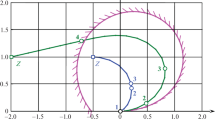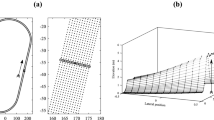Abstract
We propose a PDE approach for computing time-optimal trajectories of a vehicle which travels under certain curvature constraints. We derive a class of Hamilton–Jacobi equations which models such motions; it unifies two well-known vehicular models, the Dubins’ and Reeds–Shepp’s cars, and gives further generalizations. Numerical methods (finite difference for the Reeds–Shepp’s car and semi-Lagrangian for the Dubins’ car) are investigated for two-dimensional domains and surfaces.








Similar content being viewed by others
Notes
We note that a similar problem laying railroad tracks that connect already existing tracks was considered by Markov [35].
Later, we demonstrate that, in practice, the Lipschitz continuity of \(f\) in with respect to space can be dropped.
References
Backer, J., Kirkpatrick, D.: Finding curvature-constrained paths that avoid polygonal obstacles. In: SCG ’07: Proceedings of the Twenty-Third Annual Symposium on Computational Geometry, pp. 66–73, New York, NY, ACM (2007).
Bakolas, E., Tsiotras, P.: The asymmetric sinistral/dextral Markov–Dubins problem. In: IEEE Conference on Decision and Control, Shanghai (2007)
Barles, G., Souganidis, P.E.: Convergence of approximation schemes for fully nonlinear second order equations. Asymptot. Anal. 4(3), 271–283 (1991)
Bardi, M., Capuzzo-Dolcetta, I.: Optimal Control and Viscosity Solutions of Hamilton–Jacobi–Bellman Equations. Systems & Control: Foundations & Applications. Birkhäuser Boston Inc., Boston, MA. With appendices by Maurizio Falcone and Pierpaolo Soravia. (1997).
Bardi M., Falcone, M., Soravia, P.: Fully discrete schemes for the value function of pursuit–evasion games. Advances in dynamic games and applications (Geneva, 1992). In: Basar T., Haurie A. (eds.) Annals of the International Society of Dynamic Games, vol. 1, pp. 89–105. Birkhäuser Boston, Boston, MA (1994).
Bardi, M., Falcone, M., Soravia, P.: Numerical methods for pursuit–evasion games via viscosity solutions. Stochastic and differential games. In: Annals of the International Society of Dynamic Games, vol. 4, pp. 105–175. Birkhäuser Boston, Boston, MA (1999).
Barraquand, J., Latombe, J.-C.: Nonholonomic multibody mobile robots: controllability and motion planning in the presence of obstacles. Algorithmica 10(2), 121–155 (1993)
Bellman, R.: Dynamic Programming. Princeton University Press, Princeton, NJ, Princeton Landmarks in Mathematics (2010). (Reprint of the 1957 edition, With a new introduction by Stuart Dreyfus 2010)
Bokanowski, O., Martin, S., Munos, R., Zidani, H.: An anti-diffusive scheme for viability problems. Appl. Numer. Math. 56(9), 1147–1162 (2006)
Bokanowski, O., Forcadel, N., Zidani, H.: Reachability and minimal times for state constrained nonlinear problems without any controllability assumption. SIAM J. Control Optim. 48(7), 4292–4316 (2010)
Cardaliaguet, P., Quincampoix, M., Saint-Pierre, P.: Optimal times for constrained nonlinear control problems without local controllability. Appl. Math. Optim. 36(1), 21–42 (1997)
Cardaliaguet, P., Quincampoix, M., Saint-Pierre, P.: Numerical schemes for discontinuous value functions of optimal control. Set-Valued Anal. 8(1–2), 111–126 (2000)
Chen, G.-Q., Su, B.: On global discontinuous solutions of Hamilton–Jacobi equations. C. R. Math. 334(2), 113–118 (2002)
Chen, Y., Shu, C.-W.: A discontinuous galerkin finite element method for directly solving the Hamilton–Jacobi equations. J. Comput. Phys. 223(1), 398–415 (2007)
Chitsaz, H., LaValle, S.M.: Time-optimal paths for a Dubins airplane. In: Proceedings IEEE Conference Decision and Control (2007)
Chitour, Y., Sigalotti, M.: Dubins problem on surfaces. In: IEEE Conference on Decision and Control, Seville (2005)
Crandall, M.G., Pierre-Louis, L.: Viscosity solutions of Hamilton–Jacobi equations. Trans. Am. Math. Soc. 277(1), 1–42 (1983)
Crandall, M.G., Pierre-Louis, L.: Two approximations of solutions of Hamilton–Jacobi equations. Math. Comp. 43(167), 1–19 (1984)
Cowlagi, R.V., Tsiotras, P.: Existence and synthesis of curvature-bounded paths inside nonuniform rectangular channels. In: Proceedings of the 2010 American Control Conference, Baltimore, MD (2010).
Dubins, L.E.: On curves of minimal length with a constraint on average curvature, and with prescribed initial and terminal positions and tangents. Am. J. Math. 79(3), 497–516 (1957)
Falcone, M.: Fast marching methods for front propagation. Lecture notes at “Introduction to Numerical Methods for Moving Boundaries”, November (2007).
Falcone, M., Ferretti, R.: Semi-lagrangian schemes for Hamilton–Jacobi equations, discrete representation formulae and godunov methods. J. Comput. Phys. 175(2), 559–575 (2002)
Gonzalez, R., Rofman, E.: On deterministic control problems: an approximation procedure for the optimal cost i. the stationary problem. SIAM J. Control Optim. 23(2), 242–266 (1985)
Giga, Y., Sato, M.-H.: A level set approach to semicontinuous viscosity solutions for Cauchy problems. Commun. Partial Differ. Equ. 26(5–6), 813–839 (2001)
Hu, C., Shu, C.-W.: A discontinuous galerkin finite element method for Hamilton-Jacobi equations. SIAM J. Sci. Comput. 21, 666–690 (1999)
Ishii, H.: Perron’s method for Hamilton–Jacobi equations. Duke Math. J. 55(2), 369–384 (1987)
Jacobs, P., Canny, J.: Planning Smooth Paths for Mobile Robots, pp. 271–342. Kluwer Academic, Norwell, MA (1992).
Kao, C.Y., Osher, S., Qian, J.: Lax–Friedrichs sweeping scheme for static Hamilton–Jacobi equations. J. Comput. Phys. 196(1), 367–391 (2004)
Kao, C.-Y., Osher, S., Tsai, Y.-H.: Fast sweeping methods for static Hamilton–Jacobi equations. SIAM J. Numer. Anal. 42(6), 2612–2632 (2004)
Konkimalla, P., Lavalle S.M.: Efficient computation of optimal navigation functions for nonholonomic planning. In: Proceedings of First IEEE Int’l Workshop on Robot Motion and, Control, pp. 187–192 (1999).
Kumar, A., Vladimirsky, A.: An efficient method for multiobjective optimal control and optimal control subject to integral constraints. J. Comput. Math. 28(4), 517–551 (2010)
LaValle, S. M.: Planning Algorithms. Cambridge University Press, Cambridge, U.K. http://planning.cs.uiuc.edu/ (2006)
Laumond, J.-P., Jacobs, P.E., Taix, M., Murray, R.M.: A motion planner for nonholonomic mobile robots. IEEE Trans. Robot. Autom. 10(5), 577–593 (1994)
Lygeros, J., Pappas, G.J., Sastry, S.: An Introduction to Hybrid System Modeling, Analysis, and Control. Preprints of the First Nonlinear Control Network Pedagogical School, Athens, Greece (1999)
Markov, A.A.: Some examples of the solution of a special kind of problem on greatest and least quantities, (in russian). Soobshch. Karkovsk. Mat. Obshch 1, 250–276 (1887)
Margellos, K., Lygeros, J.: Hamilton–Jacobi formulation for reach–avoid differential games. IEEE Trans. Autom. Control 56(8), 1849–1861 (2011)
Oberman, A.M.: Convergent difference schemes for degenerate elliptic and parabolic equations: Hamilton–Jacobi equations and free boundary problems. SIAM J. Numer. Anal 44(2):879–895 (electronic) (2006).
Patsko, V.S., Turova, V.L.: Numerical study of the “homocidal chauffeur” differential game with the reinforced pursuer. Game Theory Appl. 12, 123–152 (2007)
Patsko, V.S., Turova, V.L.: From Dubins’ car to Reeds and Shepp’s mobile robot. Comput. Vis. Sci. 12, 345–364 (2009)
Reeds, J.A., Shepp, L.A.: Optimal paths for a car that goes both forwards and backwards. Pac. J. Math. 145(2), 367–393 (1990)
Reif, J.H., Hongyan, W.: Nonuniform discretization for kinodynamic motion planning and its applications. SIAM J. Comput. 30(1), 161–190 (2000)
Rouy, E., Tourin, A.: A viscosity solutions approach to shape-from-shading. SIAM J. Numer. Anal. 29(3), 867–884 (1992)
Saint-Pierre, P.: Approximation of the viability kernel. Appl. Math. Optim 29(2), 187–209 (1994)
Sethian, J.A.: A fast marching level set method for monotonically advancing fronts. Proc. Natl. Acad. Sci. 93, 1591–1595 (1995)
Sonneborn, L., Van Vleck, F.: The bang-bang principle for linear control systems. SIAM J. Control 2, 151–159 (1965)
Soueres, P., Laumond, J.-P.: Shortest paths synthesis for a car-like robot. IEEE Trans. Autom. Control 41(5), 672–688 (1996)
Sussmann, H.J., Tang, G.: Shortest paths for the Reeds–Shepp car: a worked out example of the use of geometric techniques in nonlinear optimal control, pp. 91–10. Technical report, SYCON, Report (1991).
Sussmann, H.: The Markov–Dubins problem with angular acceleration control. In: IEEE Conference on Decision and Control, San Diego (1997)
Takei, R., Tsai, R., Shen, H., Landa, Y.: A practical path-planning algorithm for a vehicle with a constrained turning radius: a Hamilton–Jacobi approach. In: American Control Conference, 2010. ACC ’10, vol. 7. Montreal, QC (2010).
Tsai, Y.-H.R., Cheng, L.-T., Osher, S., Zhao, H.-K.: Fast sweeping algorithms for a class of Hamilton–Jacobi equations. SIAM J. Numer. Anal. 41(2):673–694 (electronic), (2003).
Tsai, Y.-H. R., Giga, Y., Osher, S.: A level set approach for computing discontinuous solutions of Hamilton–Jacobi equations. Math. Comput. 72(241):159–181 (electronic), (2003).
Tsitsiklis, J.N.: Efficient algorithms for globally optimal trajectories. IEEE Trans. Autom. Control 40(9), 1528–1538 (1995)
Wang, H., Agarwal, P.K.: Approximation algorithms for curvature-constrained shortest paths. In: SODA ’96: Proceedings of the Seventh Annual ACM-SIAM Symposium on Discrete Algorithms, pp. 409–418. Philadelphia, PA, USA (1996).
Zhao, H.: A fast sweeping methog for eikonal equations. Math. Comput. 74(250), 603–627 (2004)
Acknowledgments
The authors thank Professors S. Osher, P. Souganidis and A. Vladimirsky for helpful discussions, and Dr. Y. Landa and Mr. H. Shen for taking part in the early stages of this project. Takei was supported by ONR Grants N00014-07-1-0810 and N00014-08-1-1119, and the CHASE MURI Grant 556016. Tsai was supported by a Sloan Fellowship, National Science Foundation Grants DMS-0914465, DMS-0914840, and a MURI sub-contract from Univ. of S. Carolina Grant No. W911NF-07-1-0185. Takei thanks Prof. Claire Tomlin and the Hybrid Systems Lab at UC Berkeley for their hospitality during the completion of this work.
Author information
Authors and Affiliations
Corresponding author
Rights and permissions
About this article
Cite this article
Takei, R., Tsai, R. Optimal Trajectories of Curvature Constrained Motion in the Hamilton–Jacobi Formulation. J Sci Comput 54, 622–644 (2013). https://doi.org/10.1007/s10915-012-9671-y
Received:
Revised:
Accepted:
Published:
Issue Date:
DOI: https://doi.org/10.1007/s10915-012-9671-y




